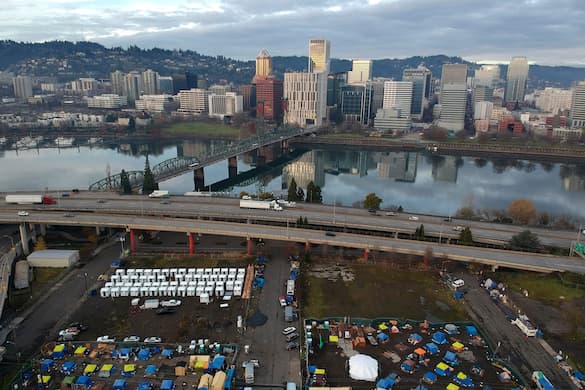Portland Homeless Enjoy Million-Dollar Views From Shacks on Filthy Waterfront as Confusion Reigns Over Who Owns the Land
Some of the structures, made of driftwood, ‘resemble beaver dams’ according to a reporter from Portland’s CBS station who traveled by boat to the encampment.

Confusion over property ownership has allowed some unsightly Portland homeless encampments to stand for years on the Willamette River riverfront, where the homeless enjoy million-dollar views of downtown from makeshift shacks.
At the crux of the issue is a lack of clarity for who exactly is responsible for enforcing rules on the land, Union Pacific railroad or the Oregon Department of Land.
One resident of a condominium complex across from the encampment, Ric Scaramella, told KOIN 6 News that anyone they contact regarding the problem — from city, county, state, and federal government officials to private property owners — always end up saying that they don’t have control over the area.
“Pretty much everyone comes back and says that they don’t have jurisdiction because it’s Union Pacific, it’s a railroad,” Mr. Scaramella said.
For its part, Union Pacific says it’s actually not sure if it owns the land, with a spokesman, Daryl Bjoraas, saying in a statement that it’s “a legal gray area.”
“Union Pacific Police regularly patrol our property and enforce trespassing laws; however, this area is particularly challenging to enforce, because cabins are near the water’s edge,” Mr. Bjoraas said. “Under Ordinary High Water Mark common law, the boundary separating public land from private land is determined by natural fluctuations of the water.”
Due to the confusion over ownership, nine or so structures have been erected along the river, giving the residents of these legally dubious structures a prime view of downtown Portland.
“These are not tents. These are structures,’ Mr. Scaramella told KOIN, which observed that some of the makeshift cabins have doors and windows and even solar panels.
“There are other structures made out of driftwood, which resemble beaver dams,” KOIN’s Dan Tilkin reported.
One woman who lives in one of these structures, who only gave her first name, Paula, told KOIN that she had been living along the river “off and on about a year-and-a-half” and is addicted to methamphetamine.
“I have anxiety issues and I think I have personality disorders too, that I’m dealing with. I think that’s what’s kept me out here so long,” Paula said.
She lives upriver from an area owned by the City of Portland called Lindbergh’s Beach, where garbage from the cabins has collected. She is on a waiting list for a county-sponsored rehab clinic.
“There’s a few shelters I like. They would have been great, except for the no-drugs thing,” Paula added. “I think my problem is I have no place to wash my hair and go to the bathroom.”
According to the Oregon Department of State Lands, it’s not clear at the moment whether dealing with the structures will fall under the jurisdiction of Union Pacific or the state.
“The bad news is, at this point it’s hard to say if we have a role,” a department spokeswoman, Ali Ryan Hansen, said in a statement. “Where public ownership of the riverbed/bank ends and upland ownership begins is complicated.”
Ms. Hansen added that property surveyors would need to go out to physically survey the property as well as review ownership records to determine who can solve the issue.
Union Pacific cited homelessness and the housing crisis as a key issue in the development of structures like the one on the riverfront, adding it would do what it could to help resolve the problem.
“Homelessness is a challenging issue and a growing social problem that state and local governments are struggling to get their arms around,” Mr. Bjoraas said. “Union Pacific is committed to working with local, state, and federal agencies to address the issue as quickly as possible and in compliance with the law.”

